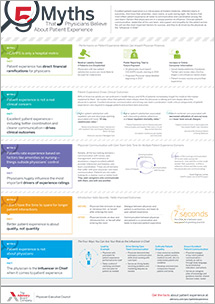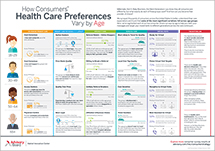Auto logout in seconds.
Continue LogoutSpeaking at the Patient Engagement and Experience Summit at HIMSS19 last month, Cleveland Clinic Chief Experience Officer Adrienne Boissy shared lessons on how to optimize patient experience. Here are seven takeaways from her talk, Jonah Comstock reports for MobiHealthNews.
1. Patient data often misses key information: patient stories.
While EHRs allow doctors to access critical patient data, that is not the only information that should inform a patient's treatment, according to Boissy.
Boissy said that the "problem" with EHRs is that they are "not actually a human being who has articulated their values and their narrative in their own words," which means that the patient's story is often missing from the big picture.
Boissy said she's envisioned a way for EHRs to feature a patient's story rather than "just regurgitat[ing] a bunch of data points." She said EHRs should include "a story place" for patients—a "part where the patient's voice shines through."
2. Don't be afraid to innovate ahead of reimbursement
Since there is no reimbursement pathway tied to patient engagement, it can be difficult to align hospital requirements with a "usable patient experience," Comstock writes. But Boissy said it's imperative for hospitals to make those hard investments.
For example, she said a hospital will never achieve patient self-scheduling "if a patient has to choose between 22,000 visit types." While reducing the number of visit types might require an "enormous" amount of "operational work, Boissy said, "[W]e have to do it." She added, "The reimbursement is not keeping up with the touches we actually need to make."
3. Listen to patients—because engagement isn't always positive for them
According to Boissy, it's important for hospitals to understand how patients want to engage in their care because engagement practices that seem standard to providers, could prove frustrating and discouraging for patients. For example, Boissy shared an encounter she had with an MS patient who "started yelling" at Boissy over the standard survey assessment.
Boissy said, "[W]hat she ended up saying was, 'I don't like coming to your office anymore because you ask me all the validated survey questions about MS, and then every time I see I'm getting worse. I'm not coming anymore.'" According to Boissy, Cleveland Clinic had never considered that some patients might not want to participate in the assessment. "We should have done better," she said.
As a result, Cleveland Clinic added questions to the assessment that gauge patients' desired engagement level. "[O]n the questionnaire we added, 'What's most important to you?'" Boissy said. "That doesn't seem like a big thing, but that doesn't exist on validated surveys."
4. Downloads do not equal engagement
A common misconception among providers is that patient activity on "patient portals" is equivalent to "patient engagement," Boissy notes.
"[W]hen we did our engagement pilots some time ago, all I saw was 'number of times downloaded, number of times patient logged in.'" Boissy said. "If patient engagement is behaviors that a patient demonstrates to take maximal advantage of tools available to them to manage their health, then downloads and logins are useless pieces of information," she added.
5. Engagement is about the individual
While population health and data analytics are important, patients should be engaged as individuals, rather than as part of a larger population, according to Boissy.
"I'd like to avoid … labels," Boissy said. "Let's not have a platform that we're going to use for" this population and for that population, she explained. "Let's have a platform for human beings that is sensitive to the needs of each one," she added.
6. Engagement is a 'two-way street'
In order to reap the benefits of patient engagement, providers should be equally engaged in the patient-provider relationship, according to Boissy. "If we have a bunch of highly engaged patients and a bunch of walking dead clinicians, that is not the vision," she said.
To ensure engagement on both sides, Boissy said the patient-provider relationship should be at the center of every tool, strategy, and platform hospitals employ for patient engagement. "[T]he drivers of exceptional experiences are the moments with the doctors and the nurses," Boissy said. "So how we're training, how we're teeing up, how we're using technology to extend and support that relationship is how we should be placing our bets."
7. Empathy is key
Boissy explained that empathy is one of the most critical aspects of the patient-provider relationship, and that hospitals and clinicians should view empathy as more than simply listening to and respecting patients.
"In the patient's eyes, the most important thing is, 'Did you care about me as a human being?'" Boissy said. "When that gets on all the surveys we'll be in business," she said (Comstock, MobiHealth News, 2/13).
Learn more: 5 resources to deliver a better patient experience
- Infographic | 5 myths physicians believe about patient experience
- Report | The executive's guide to boosting the patient experience
- Toolkit | Patient Experience 101
- Customizable Card | How Baylor eased anxiety in the waiting room
- Infographic | What your patients expect from their care—from millennials to the silent generation
Don't miss out on the latest Advisory Board insights
Create your free account to access 1 resource, including the latest research and webinars.
Want access without creating an account?
You have 1 free members-only resource remaining this month.
1 free members-only resources remaining
1 free members-only resources remaining
You've reached your limit of free insights
Become a member to access all of Advisory Board's resources, events, and experts
Never miss out on the latest innovative health care content tailored to you.
Benefits include:
You've reached your limit of free insights
Become a member to access all of Advisory Board's resources, events, and experts
Never miss out on the latest innovative health care content tailored to you.
Benefits include:
This content is available through your Curated Research partnership with Advisory Board. Click on ‘view this resource’ to read the full piece
Email ask@advisory.com to learn more
Click on ‘Become a Member’ to learn about the benefits of a Full-Access partnership with Advisory Board
Never miss out on the latest innovative health care content tailored to you.
Benefits Include:
This is for members only. Learn more.
Click on ‘Become a Member’ to learn about the benefits of a Full-Access partnership with Advisory Board
Never miss out on the latest innovative health care content tailored to you.



